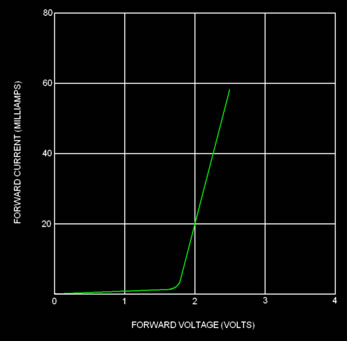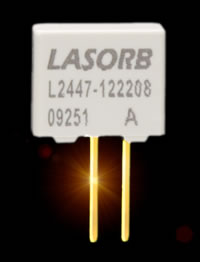1. Background
information about laser diodes
Laser diodes are an
ever-increasing part of everyday life. Indeed, when people go through the course
of a single day of their lives, they will encounter perhaps hundreds or even
thousands of laser diodes. Commonplace examples of the use of laser diodes
include CD and DVD drives, barcode scanners, laser pointers, construction
alignment devices, and police traffic radar.
Most laser diodes
can be easily damaged if their nominal voltage or current parameters are
exceeded. In fact, products that contain laser diodes often seem to mysteriously
fail, with no apparent provocation. A close examination into the failure modes
of these devices has revealed power surges during power-up/power-down sequences
and electrostatic discharge (ESD) events as two major causes of laser diode
failure.
Power-up/power-down failures
When power is being
turned on or off on a product, internal circuits can be operating outside their
intended internal power supply range for a brief period of time. As one example,
rail-to-rail operational amplifiers used in laser diode drivers may be specified
to operate with power supplies ranging from 2.7 to 5.5 volts. But the
manufacturer makes no guarantee or representation regarding what the operational
amplifier will do between a supply voltage of 0 and 2.7 volts. Because of this,
current or voltage regulation circuits may go out of balance during power-up and
power-down, and often apply an over-current or over-voltage condition to the
laser diode that is integrated within the product. These over-current or
over-voltage conditions may stress the laser diode, such that each power-up or
power-down cycle accumulates in the form of device fatigue. Eventually, the
laser diode may fail from the fatigue, leading to what the user experiences as a
mysterious failure.
Electrostatic
discharge failures
Electrostatic
discharge (ESD) may also cause mysterious device failures, and there are many
ways in which ESD might come in contact with a product. One of the most common
ways that ESD is generated occurs when a person walks across a carpeted floor,
and then touches something. A discharge can occur to anything being touched,
ranging from things that are not sensitive to ESD, such as doorknobs, to things
that are very sensitive to ESD, such as electronic products. Studies have shown
that, when an ESD discharge occurs, the discharge voltage can range anywhere
between 4,000 and up to as much as 32,000 volts DC, depending on environmental
conditions, clothing being worn, type of flooring surface, and other factors.
When an laser diode that is designed to operate with a terminal voltage of 2.2
volts experiences an ESD discharge of thousands of volts, the result can be
immediately destructive. Alternatively (and what happens more commonly), the
laser diode will have some latent damage, with dramatically reduced lifetime.
Later, when it fails in the field, the user will often blame it on infant
mortality or some other cause, not realizing that the actual damage began
earlier in the product's lifetime.
2. Laser diode
damage mechanisms
Laser diodes
typically fail as the result of two distinct damage mechanisms:
Optical
overstress
One of the damage
mechanisms is optically related, and occurs when the laser diode is producing
light (referred to as “lasing”), and the optical energy density exceeds the
laser diode’s integral mirrors’ reflective capacity. When this occurs, the
mirrored surface permanently loses its reflectivity, and the laser diode no
longer functions properly. In layman's terms, this could be thought of as the
laser light becoming so intense that it "vaporizes" the mirror surface.
Electrical
overstress
The second damage
mechanism is related to failure of a laser diode’s P-N junction itself. A severe
over-current or over-voltage power surge can cause localized heating and other
harmful phenomena, which, under extreme conditions, can actually fracture the
laser diode die (we have seen this under a microscope, brought on by high levels
of ESD).
Both of these
damage mechanisms can be provoked by an over-voltage or over-current condition.
Low-power laser diodes, that is, laser diodes whose optical output power is
below around 200 mW, are particularly sensitive to ESD. This is because they are
designed to be inherently fast devices. Indeed, low-power laser diodes are often
directly modulated and used for fiber-optic communication with data rates in the
gigahertz range. Thus the P-N junction and optical elements of a laser diode can
react very quickly to changes in voltage or current.
Therefore, in order
to be effective, an ESD protection device and method should preferably be
implemented as a proactive measure, by preventing the over-voltage or
over-current condition from happening in the first place, not by reacting to it
once it has occurred.

Current vs.
voltage profile
The figure to the
right shows the current vs. voltage profile of a typical low-power laser diode.
It can be seen that the profile is similar to other types of diodes and
semiconductor devices.
Starting from zero
volts, applying incremental positive increases in voltage (i.e., those voltages
that would tend to forward bias the laser diode), very little current flows
until around 1.8 volts is reached.
Further incremental
positive increases from around 1.8 volts causes current flow to increase at a
roughly exponential rate. However, the laser diode does not emit laser light
until the current exceeds a “lasing threshold,” which, for the laser diode
referred to here, occurs at around 30 milliamps and at around 2.2 volts. With
further incremental positive increases in voltage, current flow continues to
increase, while the optical power emitted by the laser diode increases at a rate
that is roughly proportional to current.
Once the maximum
design current for a particular laser diode is reached (which is around 35
milliamps and 2.4 volts for this laser diode), further increases in current will
likely result in failure, caused by one or both of the damage mechanisms
described above. Thus it is important to completely prevent voltage, and thus
current, from increasing beyond the absolute maximum rating for a particular
diode. In most cases, a low-power laser diode will be destroyed if the absolute
maximum ratings are exceeded, even for a brief period of time.
Note that the
figure shows only the current vs. voltage profile for positive voltages, that
is, voltages that would forward-bias the laser diode. Laser diode manufacturers
recommend that negative voltages, that is, voltages that would tend to
reverse-bias the laser diode, be avoided.
The data sheet for
an exemplary laser diode lists an absolute maximum reverse voltage of 2 volts.
In order to protect this laser diode from being damaged by ESD, the protection
means should limit positive voltages to around 2.4 volts and negative voltages
to around 2.0 volts or less. These voltages are used as a reference throughout
the rest of this discussion.

3. The LASORB
solution
To solve the ESD
problem, in 2008 we developed an electrical component called LASORB. The word
LASORB is a combination of the words “LASER” and “ESD ABSORBER”. The LASORB
component is easy for engineers to implement because it is small and can simply
be connected directly to the pins of the laser diode.
How LASORB works
LASORB's primary
means of protection is a slew-rate detector that monitors the voltage across the
pins of the laser diode. If there is a fast change-of-voltage condition
detected, this triggers LASORB to aggressively conduct the voltage (and thus
current) away from the laser diode. The conduction is initiated very rapidly –
in some cases less than one nanosecond. The conduction can last from several
microseconds, to tens of microseconds.
The
change-of-voltage approach is a very good principle to use for laser diodes
because, under ordinary circumstances, even during modulation the voltage across
laser diode pins does not change very much. Therefore any change of voltage –
especially a fast change of voltage – is an abnormal event, something that
happens only during ESD or other types of electrical faults.
Customizable to
match diode requirements
To allow for
complete flexibility and customization of individual laser diode requirements,
the LASORB component is implemented as a hybrid, containing active silicon and
passive components. And as a side-effect of the makeup of this hybrid component,
LASORB also offers protection from reverse bias conditions, thus allowing LASORB
to offer complete protection of the laser diode from a variety of electrical
faults.
LASORB is available
as a small, through-hole component, which costs between $2 and $8, depending on
the quantity. Engineers can choose from several LASORB part numbers that dictate
the actual slew rate, surge conduction time and maximum operating voltage.
4.
LASORB datasheets
There
are several standard LASORB formulations -- optimized for IR, Red, Blue and BLU-RAY
laser diode use, as well as series-connected strings and QCLs.
L44-208-X series optimized for very sensitive Red and IR laser diodes
L44-228-X series optimized for Red and IR laser diodes
L44-392-X series optimized for high power Red diodes
L44-916-X series optimized for Green laser diodes
L44-683-X series optimized for Blue laser diodes
L44-833-X series optimized for BLU-RAY laser diodes
L44-2000-X series optimized for series-connected strings and Quantum Cascade
Lasers
We
can also provide custom LASORB formulations. LASORB has several degrees of
freedom that we can tune to optimize the device to a particular laser diode
operating voltage and modulation requirement.
Please contact us for the detailed data sheets.
 Diode Bar
Diode Lasers
Diode Bar
Diode Lasers |
